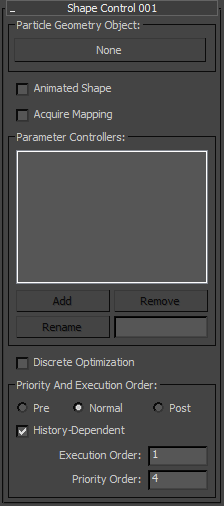Use Shape Control to assign shapes to particles. It is more flexible than the Shape Instance operator because it allows direct control of the shape parameters for each individual particle. The Shape Control suboperator can see all the shape and modifier parameters. The only restriction is that you can have no more than nine input values (Time plus up to eight controller values), and the material should be set by means other than suboperators.
Interface

- Particle Geometry Object
- Click to select a geometry object to be used as the particle instance shape.
- Animated Shape
- When on, a Time-type input for the suboperator is available. You can wire time data, and the particle shape is defined by the geometry animation and the time defined for a specific particle. This option is applicable only if the reference geometry is animated.
- Acquire Mapping
- Similar to the parameter of the same name in the Shape Instance operator.
- Parameter Controllers
- The list of the controllers for shape parameters (up to eight). Each controller is listed with its data type and name, and creates a separate input for the suboperator to which to wire a data channel. Available controllers are derived from the Particle Geometry Object.
Use the Add button to add controllers one at a time, and the Remove button to remove a highlighted controller from the list. To rename a controller, highlight it, enter a new name in the text field next to Rename, and then click Rename. The data type is preserved in the list.
- Discrete Optimization
- When off, each particle’s shape is evaluated on an individual basis. In other words, with N particles, the reference geometry is evaluated N times with different parameters; with a large number of particles this can be quite slow. However, if some parameters can take only limited number of values, and number of these values is significantly less than number of particles, it's better to turn this option on. When on, there is a small penalty due to a preliminary analysis of the input wired values to find the input value matches for different particles. On the other hand, this can be faster since the reference geometry is evaluated with fewer calls: only a call for a different input wired value.
To help speed the operation of custom operators and tests that use Shape Control in large-scale particle systems, use the Discretizator suboperator between Shape Control and its data-input stream.
- Priority And Execution Order
- Shape Control is an output-type suboperator, and as such, it has the Priority And Execution Order group of parameters. For details, see Priority and Execution Order.